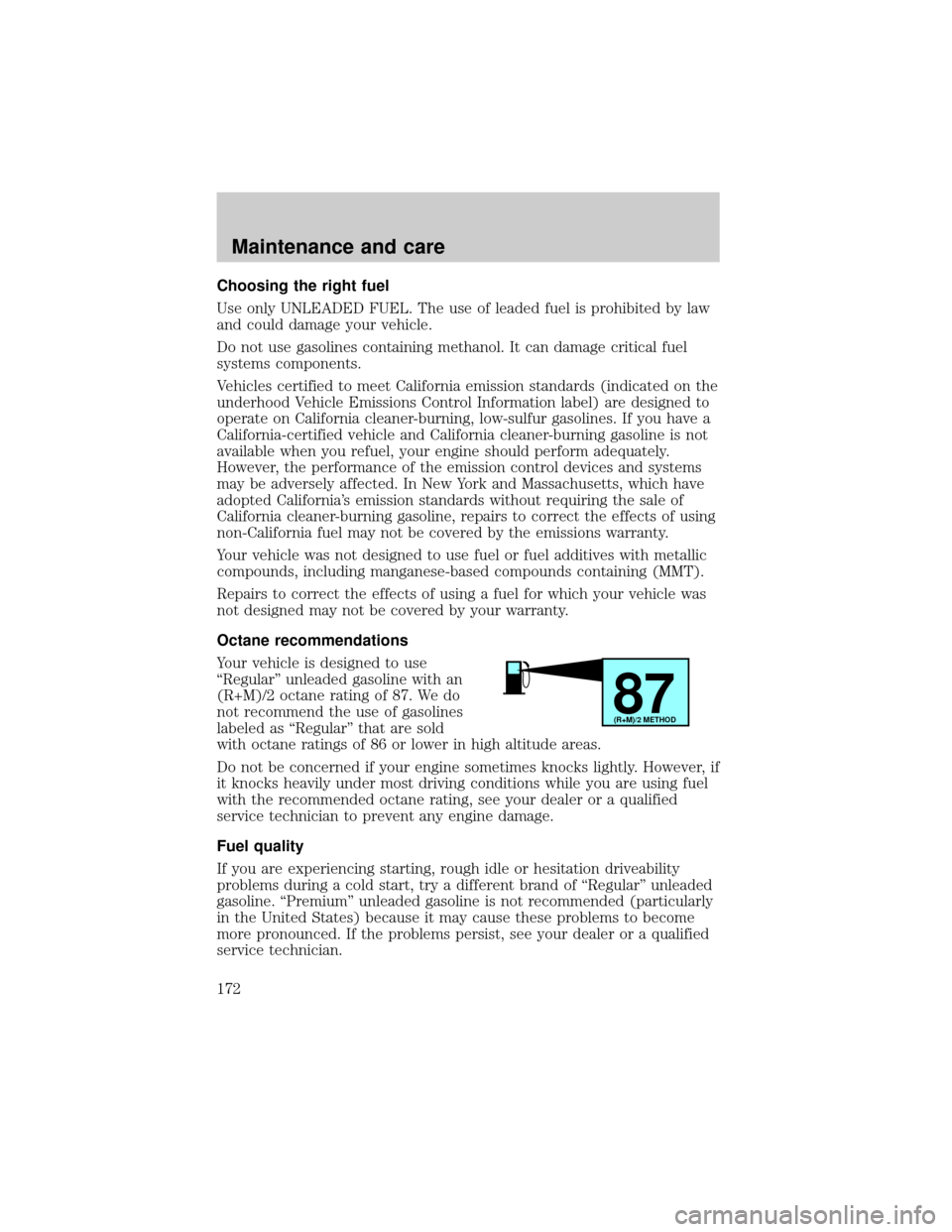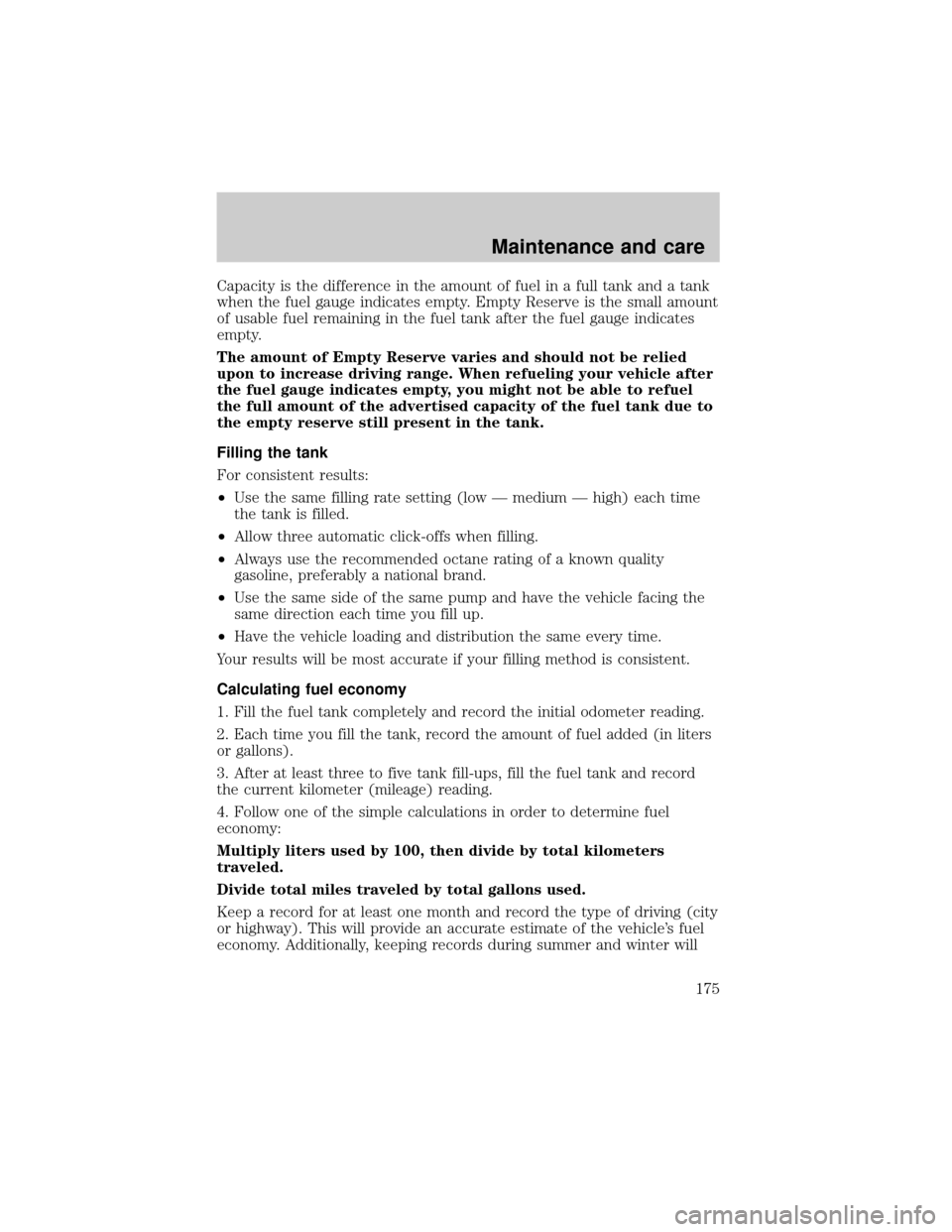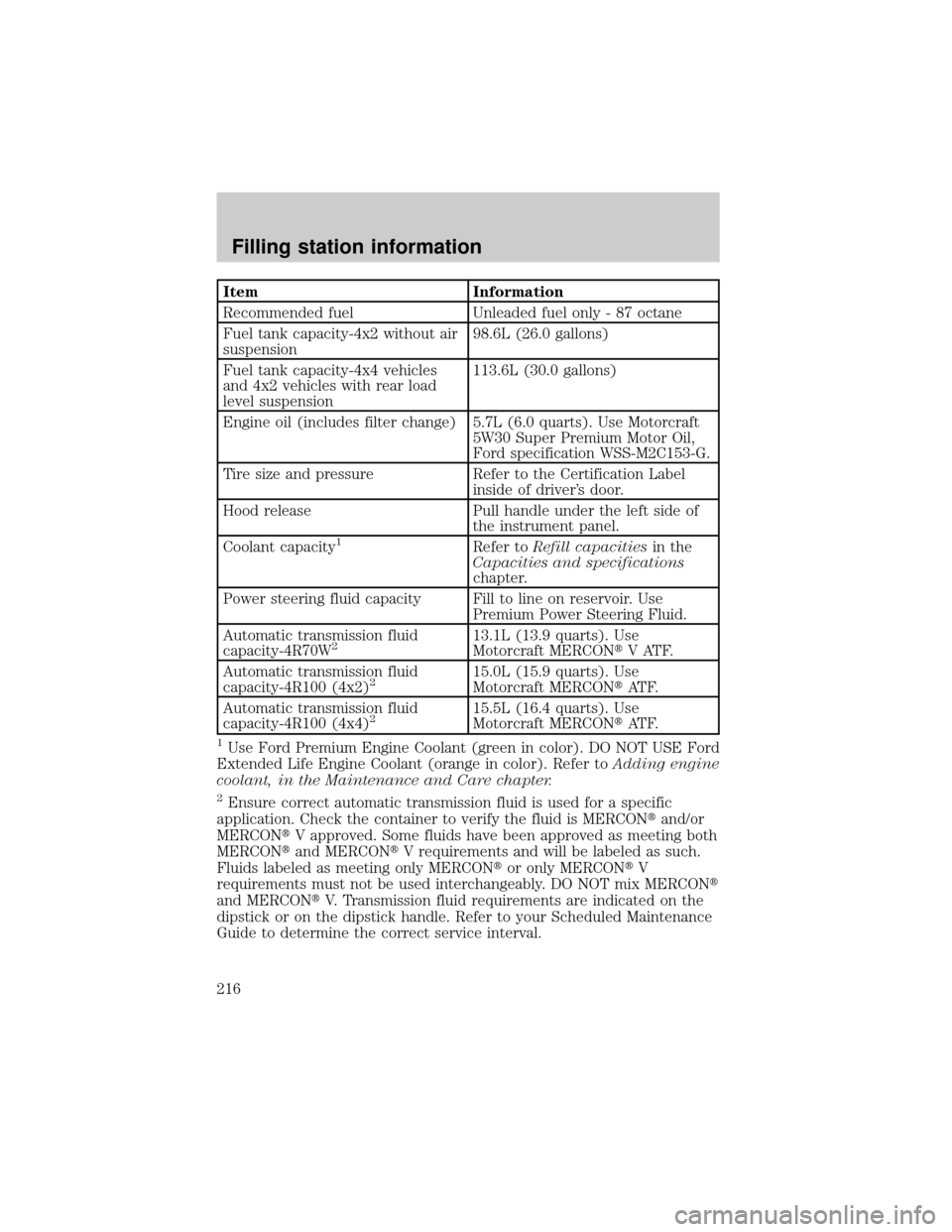1999 FORD EXPEDITION octane
[x] Cancel search: octanePage 172 of 216

Choosing the right fuel
Use only UNLEADED FUEL. The use of leaded fuel is prohibited by law
and could damage your vehicle.
Do not use gasolines containing methanol. It can damage critical fuel
systems components.
Vehicles certified to meet California emission standards (indicated on the
underhood Vehicle Emissions Control Information label) are designed to
operate on California cleaner-burning, low-sulfur gasolines. If you have a
California-certified vehicle and California cleaner-burning gasoline is not
available when you refuel, your engine should perform adequately.
However, the performance of the emission control devices and systems
may be adversely affected. In New York and Massachusetts, which have
adopted California's emission standards without requiring the sale of
California cleaner-burning gasoline, repairs to correct the effects of using
non-California fuel may not be covered by the emissions warranty.
Your vehicle was not designed to use fuel or fuel additives with metallic
compounds, including manganese-based compounds containing (MMT).
Repairs to correct the effects of using a fuel for which your vehicle was
not designed may not be covered by your warranty.
Octane recommendations
Your vehicle is designed to use
ªRegularº unleaded gasoline with an
(R+M)/2 octane rating of 87. We do
not recommend the use of gasolines
labeled as ªRegularº that are sold
with octane ratings of 86 or lower in high altitude areas.
Do not be concerned if your engine sometimes knocks lightly. However, if
it knocks heavily under most driving conditions while you are using fuel
with the recommended octane rating, see your dealer or a qualified
service technician to prevent any engine damage.
Fuel quality
If you are experiencing starting, rough idle or hesitation driveability
problems during a cold start, try a different brand of ªRegularº unleaded
gasoline. ªPremiumº unleaded gasoline is not recommended (particularly
in the United States) because it may cause these problems to become
more pronounced. If the problems persist, see your dealer or a qualified
service technician.
87(R+M)/2 METHOD
Maintenance and care
172
Page 175 of 216

Capacity is the difference in the amount of fuel in a full tank and a tank
when the fuel gauge indicates empty. Empty Reserve is the small amount
of usable fuel remaining in the fuel tank after the fuel gauge indicates
empty.
The amount of Empty Reserve varies and should not be relied
upon to increase driving range. When refueling your vehicle after
the fuel gauge indicates empty, you might not be able to refuel
the full amount of the advertised capacity of the fuel tank due to
the empty reserve still present in the tank.
Filling the tank
For consistent results:
²Use the same filling rate setting (low Ð medium Ð high) each time
the tank is filled.
²Allow three automatic click-offs when filling.
²Always use the recommended octane rating of a known quality
gasoline, preferably a national brand.
²Use the same side of the same pump and have the vehicle facing the
same direction each time you fill up.
²Have the vehicle loading and distribution the same every time.
Your results will be most accurate if your filling method is consistent.
Calculating fuel economy
1. Fill the fuel tank completely and record the initial odometer reading.
2. Each time you fill the tank, record the amount of fuel added (in liters
or gallons).
3. After at least three to five tank fill-ups, fill the fuel tank and record
the current kilometer (mileage) reading.
4. Follow one of the simple calculations in order to determine fuel
economy:
Multiply liters used by 100, then divide by total kilometers
traveled.
Divide total miles traveled by total gallons used.
Keep a record for at least one month and record the type of driving (city
or highway). This will provide an accurate estimate of the vehicle's fuel
economy. Additionally, keeping records during summer and winter will
Maintenance and care
175
Page 196 of 216

ENGINE DATA
Engine 4.6L V8 engine 5.4L V8 engine
Cubic inches 281 330
Horsepower 215 @ 4500 rpm 235 @ 4250 rpm
Torque 290 lb.-ft. @ 3250 rpm 325 lb.-ft. @ 3000 rpm
Recommended fuel 87 octane 87 octane
Firing order 1-3-7-2-6-5-4-8 1-3-7-2-6-5-4-8
Spark plug gap 1.3-1.4 mm
(0.052-0.056 inch)1.3-1.4 mm
(0.052-0.056 inch)
Ignition system EDIS Coil on plug
Compression ratio 9.0:1 9.0:1
VEHICLE DIMENSIONS
Vehicle dimensions 4x2 mm (in) 4x4 mm (in)
(1) Overall length 5 196.0
(204.6)5 196.0
(204.6)
(2) Vehicle width 2 000.0
(78.7)
12 000.0
(78.7)1
*width including
mirrors2 293
(90.3)2 293
(90.3)
*with optional running
boards2 071
(81.5)2 071
(81.5)
(3) Overall height
21 943.0
(76.5)1 992.0
(78.4)
(4) Wheelbase 3 023.0
(119.0)3 023.0
(119.0)
(5) Track - Front 1 661.0
(65.4)1 661.0
(65.4)
(5) Track - Rear 1 663.0
(65.5)1 663.0
(65.5)
1Vehicle width, including mirrors: 2 293.0 mm (90.3 in)
2Vehicle equipped with 16º tires and base suspension
Capacities and specifications
196
Page 214 of 216

fuel reset ...................................11
low fuel ........................................6
low washer fluid .......................10
safety belt ...................................8
service engine soon .................6,7
turn signal indicator ...................8
Locks
childproof ..................................61
doors ..........................................61
Lumbar support, seats ..........74,75
Message center ......................14,57
english/metric button ...............15
menu button .............................15
Mirrors
fold away ...................................63
heated ...................................62,63
side view mirrors (power) .......62
Moon roof ....................................57
Motorcraft parts ........................174
Octane rating ............................172
Overdrive .....................................55
Parking brake ............................107
Parts (see Motorcraft parts) ....190
Power adjustable foot pedals .....18
Power distribution box (see
Fuses) ........................................133
Power door locks ...................70,71
Power steering ...................108,109
fluid, checking
and adding .......................158,159
Radio .............................20,21,22,23
Relays .................................129,136
Remote entry system ............67,68
illuminated entry ......................70
locking/unlocking doors ...........68
replacement/additional
transmitters ...............................70
replacing the batteries .............69
Roof rack ...................................127
Safety Compliance
Certification Label ....................198
Safety defects, reporting ..........211Safety restraints
cleaning the safety belts ...88,189
extension assembly ..................87
for children ...............................93
lap belt ......................................86
warning light and chime ..........88
Seat belts (see Safety
restraints) ................83,84,85,86,87
Seats ............................................74
child safety seats ......................94
cleaning ...................................189
Servicing your vehicle ..............148
Snowplowing .................................3
Special notice ................................3
ambulance conversions ..............3
utility-type vehicles ....................3
Specification chart, lubricants .194
Speed control ..............................49
Starting your vehicle .........100,102
jump starting ............142,143,145
preparing to start your
vehicle .......................................65
Steering wheel
tilting .........................................53
Tires .............................166,167,168
changing ...........................137,138
checking the pressure ............168
replacing ..................................169
rotating ....................................168
snow tires and chains ............169
tire grades ...............................167
treadwear ................................167
Towing ....122,123,124,125,126,127
wrecker ....................................147
Traction-lok rear axle ...............110
Transmission .............................111
fluid, checking and adding
(automatic) ...............159,160,161
Vehicle dimensions ...................196
Vehicle Identification Number
(VIN) ..........................................198
Vehicle loading ..........................119
Index
214
Page 216 of 216

Item Information
Recommended fuel Unleaded fuel only - 87 octane
Fuel tank capacity-4x2 without air
suspension98.6L (26.0 gallons)
Fuel tank capacity-4x4 vehicles
and 4x2 vehicles with rear load
level suspension113.6L (30.0 gallons)
Engine oil (includes filter change) 5.7L (6.0 quarts). Use Motorcraft
5W30 Super Premium Motor Oil,
Ford specification WSS-M2C153-G.
Tire size and pressure Refer to the Certification Label
inside of driver's door.
Hood release Pull handle under the left side of
the instrument panel.
Coolant capacity
1Refer toRefill capacitiesin the
Capacities and specifications
chapter.
Power steering fluid capacity Fill to line on reservoir. Use
Premium Power Steering Fluid.
Automatic transmission fluid
capacity-4R70W
213.1L (13.9 quarts). Use
Motorcraft MERCONtV ATF.
Automatic transmission fluid
capacity-4R100 (4x2)
215.0L (15.9 quarts). Use
Motorcraft MERCONtAT F.
Automatic transmission fluid
capacity-4R100 (4x4)
215.5L (16.4 quarts). Use
Motorcraft MERCONtAT F.
1Use Ford Premium Engine Coolant (green in color). DO NOT USE Ford
Extended Life Engine Coolant (orange in color). Refer toAdding engine
coolant, in the Maintenance and Care chapter.
2Ensure correct automatic transmission fluid is used for a specific
application. Check the container to verify the fluid is MERCONtand/or
MERCONtV approved. Some fluids have been approved as meeting both
MERCONtand MERCONtV requirements and will be labeled as such.
Fluids labeled as meeting only MERCONtor only MERCONtV
requirements must not be used interchangeably. DO NOT mix MERCONt
and MERCONtV. Transmission fluid requirements are indicated on the
dipstick or on the dipstick handle. Refer to your Scheduled Maintenance
Guide to determine the correct service interval.
Filling station information
216